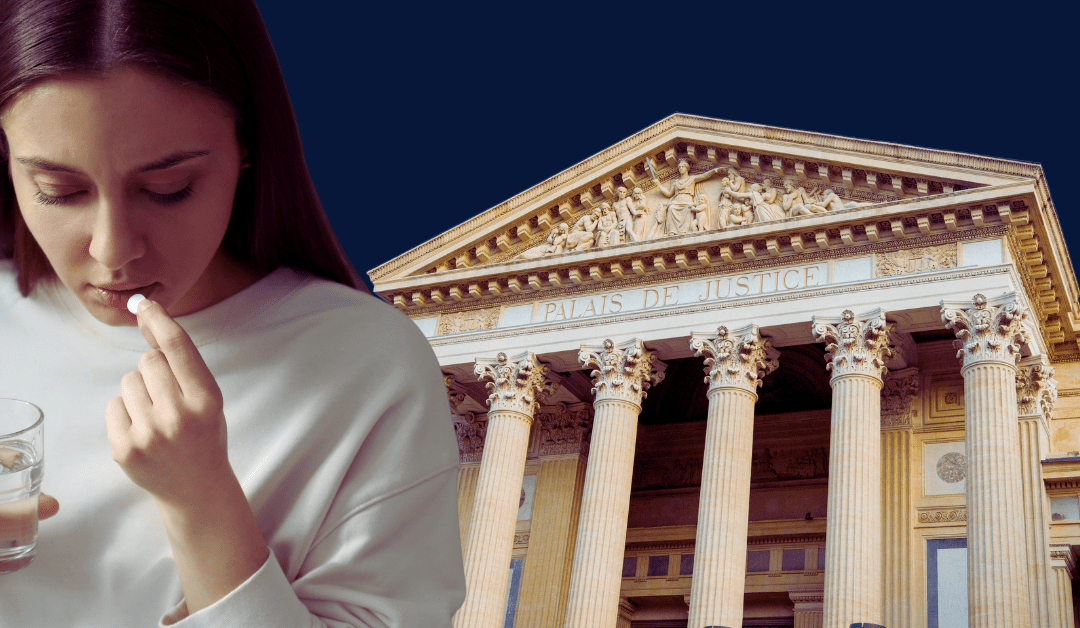Anyone who’s stocked up on groceries lately can tell you that when it comes to the economy, what matters most is that you can afford what you need, when you need it – like, for example, a gallon of milk. But the price of that milk is based on a lot of factors, and during an election year, politicians use those factors to influence voters. That’s why we’re taking a closer look at what’s behind the sticker shock, what could make the economy better, and which politicians have plans you should know about.
Let’s Talk About Inflation
In June, inflation in the US hit a four-decade high of 9.1%.
Are we alone? No. A Pew Research Center analysis of 44 advanced nations found that in 37 of those countries, the average annual inflation rate was at least twice what it was the year before.
How does inflation happen? Charley Ballard, an economics professor at Michigan State University who specializes in analyzing Michigan’s economy and tax systems, said inflation comes from two situations:
- The number of available goods drops (but the demand for them doesn’t).
Example: An early frost kills fruit crops. - The demand for goods quickly goes up (but there aren’t enough goods).
Example: Toilet paper at the start of the pandemic.
“And what we have seen, in the last two years, is the supply chain struggling to keep up with the demand,” Ballard said.
Who or what is responsible for the current level of inflation? Let’s look back over the past few years to find out.
Start with: Supply
Supply: The amount of a resource that’s available to consumers.
Supply chain: The network involved in getting resources to consumers.
What happened: Our supply chain got – then stayed – disrupted.
Here’s how supply has been impacted:
- COVID-19 kept workers across the globe from producing and transporting goods. Even now, COVID-19 continues to impact the supply chain.
- The war in Ukraine has cut off huge supplies of oil from Russia, and grain from both Russia and Ukraine. The US relied on Russian oil for about 3% of its supply. When the US and other countries started sanctioning Russia as a “powerful blow to Putin’s war machine,” there was a predicted drop in the supply of oil, increasing prices for everyone.
- The labor shortage has been coming on for years, Ballard said, and COVID-19 accelerated it. Starting in the 1970s, the labor force participation rate increased exponentially as women were entering the workforce, and peaked in 2000 at 67.3% of the U.S. population. Since then, the most reliable way to increase participation in the labor force has been through immigration.
However, as Baby Boomers retire and immigration has become an increasingly toxic political debate, Ballard hypothesizes that immigration policies can’t help us right now.
According to the National Immigration Forum, there are about 2 million fewer working-age immigrants in the US than pre-pandemic levels, the loss of which impacts both the supply chain and the labor force.
Next: Demand
Demand: How much consumers want supplies.
What happened: Economic policies crashed with a pandemic.
“For a long time, we have been pursuing policies that pump up demand,” Ballard said.
Both the federal government and the Federal Reserve have been engaging in expansionary policy for the last four decades. Expansionary policy is a type of legislation that injects money into the economy, either through government spending or increased lending to businesses and consumers. The approach over the past 40 years has put more money into the economy and into the hands of consumers who want to buy things.
Side note: The two most recent policies that have put more money into the economy in a way that has increased inflation are the Trump-era tax cuts and COVID-19 stimulus checks.
“How can I argue against trying to prevent the worst effects of COVID?” Ballard said. “The problem is that those stimulus checks were not targeted nearly as much as they should have been.”
Experts say the best way to target aid like the stimulus checks is through income thresholds, according to CNBC. For example, the American Rescue Plan gave $1,400 to single adults who earned up to $75,000, and partial checks to people who made $75,000 to $80,000. Republican opponents of the plan wanted the cutoff to be $40,000.
However, from March 2020 to April 2021 – when three stimulus checks were distributed – consumer spending went up by almost $1.9 trillion.
But if the government’s been practicing expansionary policy for 40 years now, why has inflation only peaked now?
Ballard said that the four decades prior to COVID-19 had two key features: fracking in the United States kept oil prices low, and America had built up a sprawling supply chain that could keep up with demand. That supply chain, however, took a hit with the pandemic.
“The old adage goes, ‘a chain is only as strong as its weakest link,’” he said. “We had these elaborate supply chains with all sorts of links. Then COVID broke some of the links.”
Important: Wages
Wages haven’t risen in harmony with inflation in a long time. Now that inflation is extremely high, wages are even further behind.
In 2018, organizers gathered enough signatures to put a minimum wage increase on the ballot, but the Republican-led Legislature adopted the proposal before it could reach the ballot, using a constitutional loophole, and amended it for slower implementation.
The legislature’s changes resulted in the minimum wage increasing from $9.25 to $12.05 per hour by 2030, slowing what was an initial proposed increase to $12 by 2022.
In 2007, the Democratic Congress raised minimum wage to $5.85 and had it set to raise to $7.25 an hour by 2009, where it still sits today.
Both President Joe Biden and congressional Democrats support raising the minimum wage to $15, but Republicans argue it could force small businesses to lay off workers.
According to a survey by CNBC, One-third of small businesses anticipate laying off workers if Congress increases the federal minimum wage to $15 an hour.
If the minimum wage was raised to $10.10, it would take 900,000 families out of poverty, according to a 2014 Congressional Budget Office report. But it would also cost 500,000 workers their jobs.
William Adams, an economics professor at the University of Michigan, said the present situation is reminiscent of the 1970s and 80s, when an oil embargo increased energy prices. Those higher prices led to inflation, and wages didn’t rise to meet the higher costs of goods. The recession that followed, Adams said, has some important similarities to today’s outlook. Namely, “stagflation.”
“Meaning on the one hand, very slow growth, but on the other hand, inflation,” Adams said. “In other words, the worst of both worlds.”
Consider: Price Gouging
Price gouging: When a seller increases the price of supplies to an unreasonable extent, taking advantage of a higher demand for items to make more money.
“It’s hard to explain record-high profits and record-high [price] increases at the same time,” said Jim Ananich, D-Flint, the Senate Minority Leader in Michigan.
Ananich is referring to price gouging. Earlier this year, reports revealed that 28 of the world’s largest oil and gas companies made close to $100 billion in combined profits during the first three months of 2022.
Meanwhile, gas prices rose nearly 38% during that same time, and have increased another 16% since.
Ballard said while he thinks there are some companies or executives using the economic downturn as an opportunity to make more money, it’s not “the biggest part of the picture right now.”
It’s also illegal. In Michigan, the Consumer Protection Act prohibits price gouging. Complaints are handled by a team in the attorney general’s office.
Right now, for example, Attorney General Dana Nessel has issued a warning to residents in the Benton Harbor area for price gouging of bottled water. “With concerns growing over lead contaminated drinking water in Benton Harbor, health officials are advising residents to use bottled water for drinking, cooking, teeth brushing, and mixing baby formula,” said the warning. “The demand for bottled water has created an opportunity for local retailers to take unfair advantage of consumers who need to be able to buy affordable product.”
Whose Policies Help? Whose Hurt?
Both parties are acknowledging inflation and the economic stress that Americans are under, but they have different ideas for how to get prices out of their upward clime.
Here’s a breakdown of the two major parties’ economic ideologies and plans.
On taxes:
Republicans favor regressive taxation, which is where the tax imposes a harsher burden on lower-income households than higher-income ones. This is because they are taxed the same or more than higher earners, but $100 is worth more to a low-income household compared to a high-income one.
For example, in Michigan, sales tax is 6%. If someone who makes $30,000 and someone who makes $300,000 both spend $3,000 a year on household necessities, like toilet paper, they both pay $180 on sales tax. For someone making $30,000, that is .06% of their income, which seems small, but for someone making $300,000, it’s only .006%.
Many initiatives pushed through by the Republican Party have cut taxes for high-income earners and businesses.
For example, in 2018, the Tax Cuts and Jobs Act, Trump’s tax reform, cut the top income tax rate to 37% and lowered the corporate tax rate to 21%.
On the other hand, Democrats believe in progressive taxation, which puts higher taxes on high-income households, big businesses and investments.
For example, in 2010, Obamacare raised taxes on high incomes and investments.
In 2022, here are the party’s economic positions and how they are posing to solve the current economic crisis the country is facing.
Democrats:
- End tax subsidies for oil companies––meaning the government will no longer give money to the oil industry, in which 28 of the largest producers made close to $1 billion in combined profits the first three months of 2022.
- End oil companies’ price-gouging
- Make corporations pay higher taxes––currently the US is in the middle of the pack regarding how much corporations pay in taxes.
- Minimum wage should keep up with inflation and allow someone to be able to afford to live.
- Reduce the cost of insulin
Legislation:
- An oil-price gouging bill was passed by the House
- Legislation to lower the cost of food and fuel was announced in June
But…
Democratic senators have been trying to pass a tax and social spending bill for over a year, but Sen. Joe Manchin (D-W.Va.) told party leaders he won’t support it if it increases taxes on the wealthy or corporations.
The spending bill would increase taxes on the wealthy and corporations, and includes $175 billion toward affordable housing and $190 billion for child tax credits.
Republicans:
It’s not super clear; Republicans have yet to come together on a plan to lower prices.
What they have been doing is rallying around the idea that President Biden’s deficit spending is the cause for inflation, but most of the deficit spending in the past six years was signed under President Trump.
Legislation:
- Sen. Rick Scott (D-Fl.) released his “11 Point Plan to Rescue America,” but both Democrats and his fellow Republicans didn’t want anything to do with the plan, which proposed tax hikes on low-income households.
- Other than that, Congress Republicans have been busy blocking a bill that would allow people to travel out-of-state for an abortion without fear of prosecution.
- Republicans are also laying the groundwork for anti-LGBTQ+ legislation.
Meanwhile, in Michigan
- According to Michigan Association of United Ways’ 2021 ALICE report, 38% of Michigan residents struggle to afford housing, childcare, food, technology, health care and transportation.
- Food banks are asking for state assistance as their demand increases.
- A suspension on the state gas sales tax passed the Senate with bipartisan support.
- Republicans in the legislature approved a $2.5 billion tax cut plan, but Gov. Gretchen Whitmer vetoed the plan, arguing it violated a constitutional clause.
- Gov. Whitmer has proposed tripling the Earned Income Tax Credit, which would put about $350 a year into qualifying recipients’ pockets.
- Gov. Whitmer is calling for a one-time $500 rebate for Michiganders to help ease some of the economic pain.
Final Say:
Senate Minority Leader Jim Ananich (D-Flint), on if the parties will be able to compromise and pass economic legislation:
“I hope so. I hope we do. I haven’t seen it yet. I’ve seen a lot of partisanship right now. It’s an election year and that’s normal, but I think when we have this sort of inflationary issue that’s going on right now, people are struggling. I think it’s time to come together. There are temporary things we can do short-term for relief, like direct checks, and there’s long-term things we can do. I think we should try both, and I’m open to both.”

VIDEO: Trump isn’t the only republican facing charges for alleged financial crimes
https://www.tiktok.com/@gandernewsroom/video/7361494909938978090 A whole lot of Michigan Republicans and lobbyists are facing criminal charges for...

VIDEO: It’s expensive to be poor in Michigan
https://www.tiktok.com/@gandernewsroom/video/7361154790300060974 Ever heard of predatory payday loans? Here’s how new laws could help protect...

Here’s everything you need to know about this month’s Mercury retrograde
Does everything in your life feel a little more chaotic than usual? Or do you feel like misunderstandings are cropping up more frequently than they...

The ’Gander wins multiple 2023 Michigan Press Association awards
MICHIGAN—The ’Gander Newsroom has earned multiple awards in the 2023 Michigan Press Association Better Newspaper Contest. The awards were announced...

Michigan Republicans ask Supreme Court to restrict medication abortion access
A lawsuit supported by Republicans could disrupt access to the most common form of abortion—even in Michigan, where reproductive rights are...






